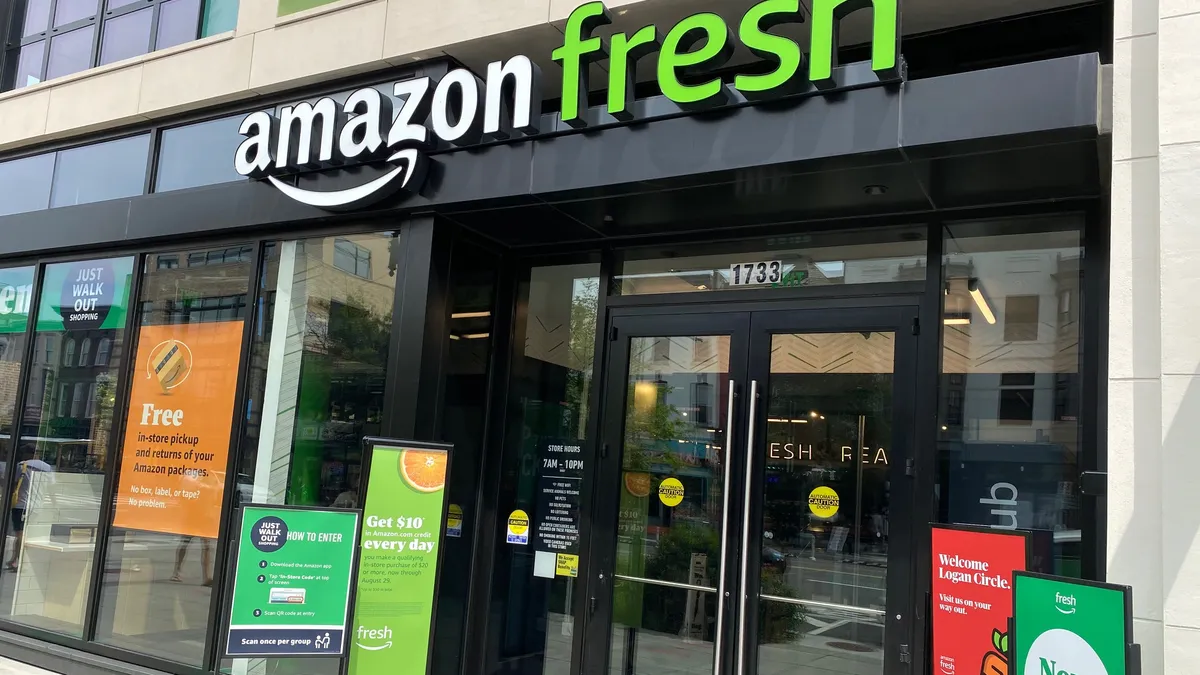Dive Brief:
- Amazon took the top spot in the latest Retailer Preference Index from data firm Dunnhumby for a second straight year, while its Amazon Fresh grocery brand grabbed the No. 5 spot in its first appearance on the index.
- Rounding out the other top spots in the index, which incorporated a survey of 10,000 households along with an analysis of top sales drivers, were H-E-B, Market Basket, Wegmans, Aldi, Trader Joe’s, Sam’s Club, Costco and Walmart Neighborhood Market.
- The results reflect the growing importance of digital as a core value for consumers. “2021 was the year that grocery retail became truly omni-channel,” Grant Steadman, president of North America for Dunnhumby, said in a statement. “Retailers who delivered on their customers' evolving needs in-store and online performed best.”
Dive Insight:
Price remains the top preference driver for consumers when picking their favorite grocers, Dunnhumby noted in its report. But for the first time this year, digital matched quality for the second spot, reflecting the growing power of omnichannel shopping that's been supercharged by the pandemic.
Dunnhumby noted that the top grocers in its latest Retailer Preference Index, which measured consumer opinions on 64 companies, were in many cases those that have the resources to meet rising omnichannel demand while also investing in pricing and value perception.
Amazon, which had built out a leading e-commerce network prior to the pandemic, has been a major beneficiary of this shift in core consumer demands, the firm noted. In addition to its e-commerce platform taking the top spot for a second straight year, its dedicated grocery brand made a strong showing in its first year on the index despite only having a smattering of stores so far and a mostly online presence.
The firm said several mid-sized grocers that have a keen understanding of their local markets also made a strong showing. This includes regional favorites H-E-B and Wegmans, which frequently top consumer polls. Market Basket, which has a loyal following in the Northeast and jumped three spots in the index compared to last year, doesn’t offer online shopping and only recently rolled out a website, underscoring the importance of service and low prices to shoppers even in an increasingly digital industry.
“The challenges for most other retailers are significant, but a number of mid-size grocers gained momentum by understanding their customers better and differentiating their offering accordingly,” Steadman noted in the announcement.
Warehouse retailers that cater to one-stop shopping ranked high on the index, with Sam’s Club, Costco and BJ’s Wholesale Club all showing up in the top 15. Supermarket chains Kroger and Ahold Delhaize, meanwhile, had a few banners that made it into the top 30. Ahold Delhaize’s The Giant Company came in 17th and Food Lion claimed the 28th spot, while Kroger’s Ralphs banner claimed the 24th spot, and its Harris Teeter followed just behind in 25th. Albertsons didn’t have any banner chains in the index’s first or second quartiles.
What sets the top grocers in its rankings apart from other competitors, Dunnhumby said, is the sharp differentiation they’ve carved out along with being nimble enough to rapidly respond to consumer preferences and make tradeoffs where necessary. Strong private label brands are also a common thread among top performers, the firm noted.
The rise of Amazon in its rankings and the shifting preference drivers reflect revised shopping habits among consumers that are shifting the power dynamics in grocery and ushering in what Dunnhumby calls an “Age of Reinvention” among retailers. This includes eating at home more often, relying on online channels and visiting fewer stores.
“More than in any other industry, consumers say that their behaviors in grocery have changed permanently,” Dunhummby noted in its report.
Retailers that are able to adjust and, in some cases, reinvent themselves, are poised to reap the spoils in this new omnichannel age, Dunnhumby noted. Grocers that ranked in the top quartile of its latest index are seeing long-term sales growth that is nine times greater than competitors in the fourth quartile.
Dunnhumby’s rankings came through analyzing its consumer survey to determine their top needs, or preference drivers, as well as emotional bonds shoppers formed with grocers. The seven drivers of customer preference, according to the firm, are price, quality, digital, operations, convenience, discounts, rewards and information, and speed.













